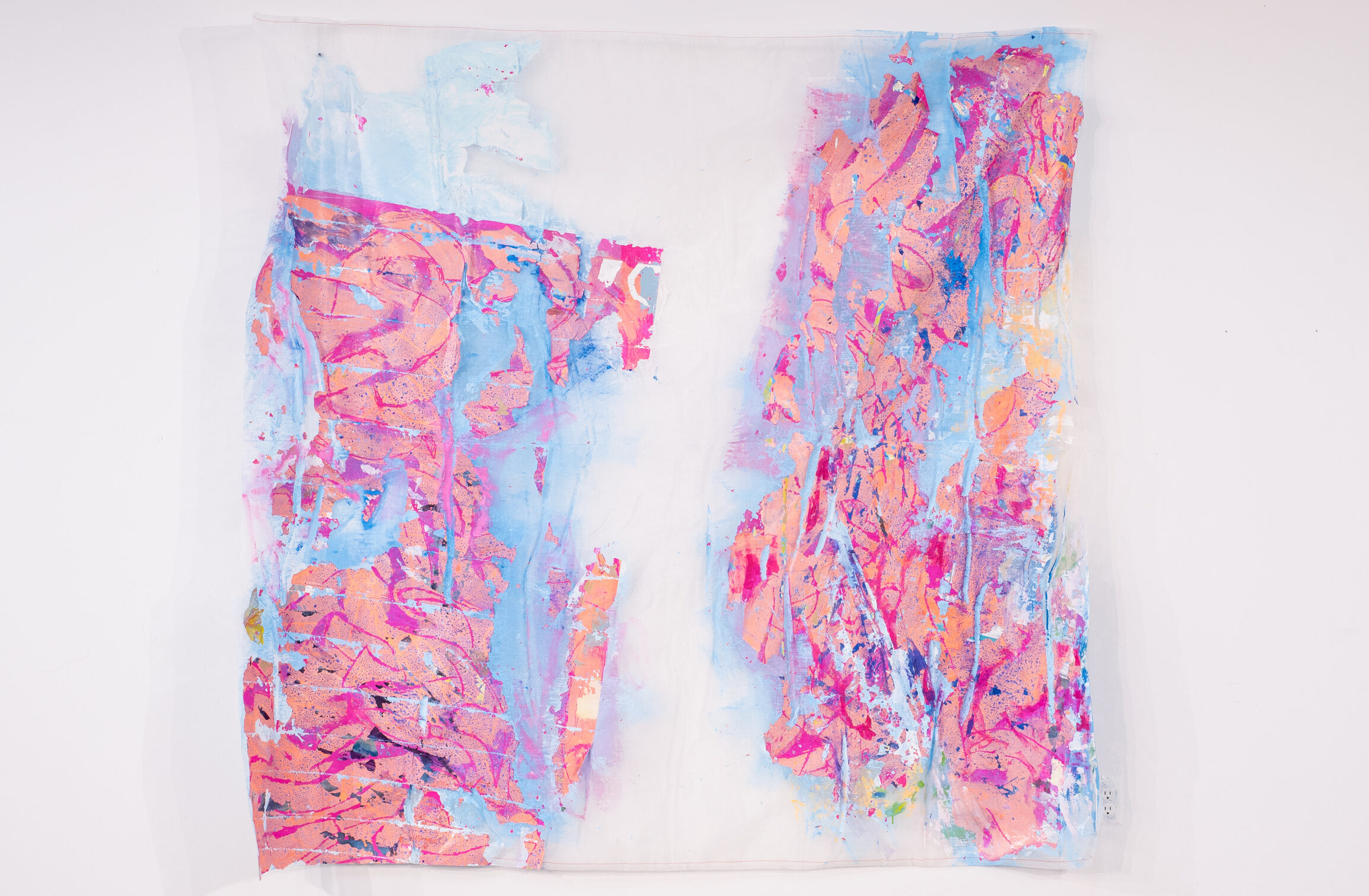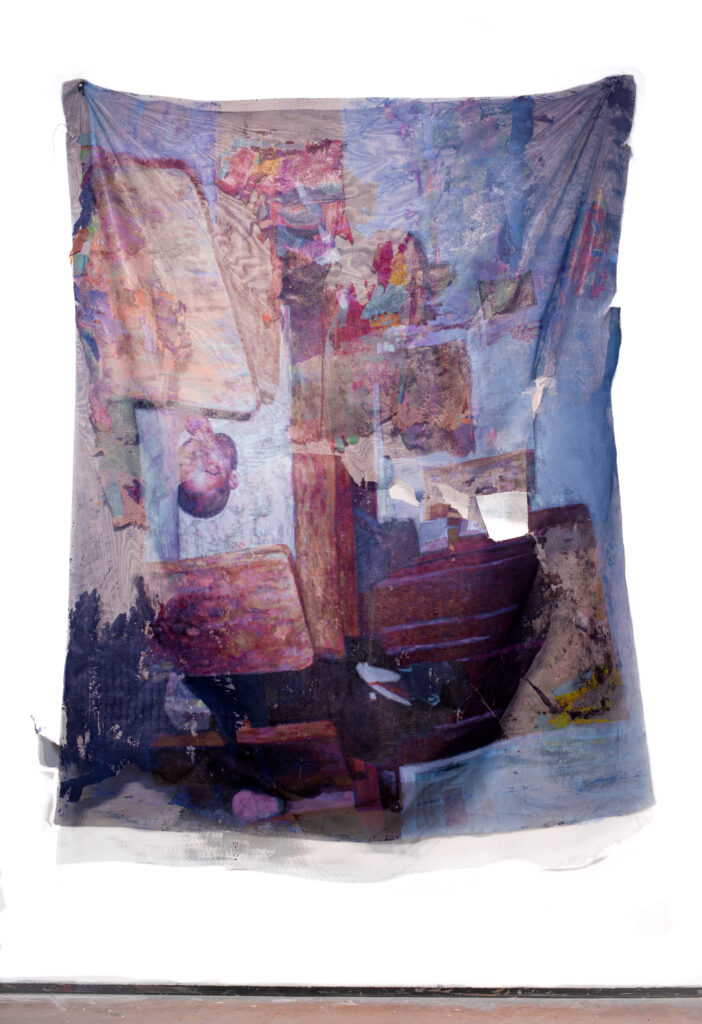October 26, 2023
Artist to Watch
CHRISTOPHER PAUL JORDAN
NB: Can you tell us about your experience with art before starting or completing your MFA and how you arrived at where you are now with your practice?
CPJ: I’ve always thought of myself as a public artist. I know perhaps that’s a bad word in the Gallery scene but there’s something about work that has a sense of collective ownership that has always resonated for me. Over the years I’ve created a lot of public murals, but throughout the displacement and forced migration of thousands of folks out from my hometown a lot of these murals ended up lost, painted over, and removed. I also grew up next to a salvage yard that has remnants of Black neighborhoods demolished over the past 60 years. Some of them were torn down when i-5 was built. That made me want to create. So as I struggled to maintain my sense of home despite the world around me being shredded to pieces, I started painting on fragments of buildings and houses and eventually window screens.
There’s something about the way that screens respond to the brush, pushing back and even fighting against me. Painting a window screen is to some extent a futile process, the paint falls right out, so it takes layers, and layers, and layers of activity to have a surface to begin with. Negotiating with futility, with the completely illogical compulsion to do something like paint at the world’s end…I didn’t realize it at first but painting the screens had physicalized my process of working through grief. A lot of the material in my paintings is me reckoning with the experience of loss and surrender. What excited me about grad school was equally what scared me the most: the reality of leaving home. School took away my defense mechanisms and challenged me to develop a deeper faith. Both my own creative power and that power of my community. A power that won’t be stopped.

NB: Let’s talk about your process. Where do you begin? How do you approach each new painting or installation?
CPJ: Each painting begins with the trimmings, the scraps, bones, and remains of the previous painting. I have painting ‘grounds’ that I re-use, each one with its own history that has accumulated over time. So the painting starts with me responding to fragments that remain on the surface. Oftentimes I work layering color on a surface over the course of months, not really knowing what it’s going to become. After cutting, reorganizing, and collaging together different sections, I use a window screen material to peel those paintings off of their original surface and see what kind of information is left behind.
It’s funny because during school I went through a kind of horrible breakup, and that final loss pricked open my unaddressed grief. Grief of my own estrangement from my parents, the loss of family and friends, grief of the loss of my spiritual home. So I’ve ended up working essentially with separation, peeling and painting off, or ripping apart, seeing two things that are interconnected, and the ways that their histories are forever embedded in one another. The process of painting has really deepened my understanding of the way that experiences of relocation shape us (whether in terms of forced migration, family estrangement, or changes in relationships) and I’m learning about how all these losses contribute to who we become. When I look at some of the paintings, all I see is the pieces that are missing. Actually, in order to convince myself to let work go, I had to actively start painting memories that I needed to separate myself from. In some ways, I think that the loss these paintings undergo helps me appreciate just how vulnerable and how fleeting our memories are.

NB: Beautiful. How do you relate your painting process and photography, to the themes of memory and the internet?
CPJ: There’s this concept of ‘living systems’ that is fascinating to me. These are systems in constant change, like the human body or the weather and if you introduce a new element it is impossible to predict how the system will respond. There’s a degree of chaos, autonomy, and unpredictability, which expresses its existence beyond our control.
These systems relate to photography and the internet through latency, which is explained as the time delay between cause and effect. For example, we can talk about pandemics, whether we’re talking about HIV/AIDS or COVID, there’s a latent time between when an illness is introduced into our body and the period where we actually are able to recognize its symptoms and effects – which is a complex concept for us to deal with socially. In photography, the concept of latency is present when you are developing an image. The image isn’t there at first, but when dipped in this liquid and the image surfaces. So this concept of a latent image just fascinated me from the very beginning. I’d say my paintings are reckoning with the concept of latency in different ways: At a personal level, there are qualities of our parents and grandparents that perhaps we’re unaware of, and that suddenly get expressed through a new generation, meaning we can probably trace some of our most bizarre tendencies from family members generations back. In a way my paintings take shape in a somewhat similar way whether it is through the course of several paintings or maybe through just one painting: Let’s say you’re looking at the surface and you see one little speck of of magenta, but then you look back and there’s all this background of magenta, teeny dots of history peeking through little small quirks that are the sort of like latent histories, like ready to announce itself, ready to burst forward.
NB: So now, can you tell us about the subjects in your paintings? Who are they, how do you choose them, and how does this connect to your community?
CPJ: All of my images come from daily life, from about 4 to 6 years ago, and anyone in the frame is usually a friend, relative, or someone I’ve spent time with. It’s often the strange ones that speak to me, the photos I don’t understand. I paint them because I don’t understand them.
But my most painted person is Gwen Jones. She is the inheritor and manager of the salvage yard. She’s a photographer actually, and describes herself as my muse. She’s kind of an archivist of neighborhood history. My family lost the house where I grew up, and so the salvage yard, that space, is literally physically, the closest thing that I have to home. So I end up there with her often. In there the world disappears.

NB: What are some of your upcoming projects, residencies or exhibitions that you’re excited about?
CPJ: As far as public art projects I’m working on two large scale sculptures, they’re both around 35 feet. One is a freestanding structure and the other one is a suspended structure that’s almost like a metal tapestry piece. I’m working with a couple engineers on those pieces right now. My favorite thing about that work is that I can do it from anywhere, and so we get to collaborate online and play with different pieces of things, share models, etc. The sculptures will be sited along the new transit line between Seattle and Tacoma and Washington.
And at the moment I’m in Mexico City for a couple months working on a solo show at Naranjo 141. I’m reprocessing a lot of my own religious conditioning from early life, engaging with biblical rapture to work through aspects of fundamentalism, spiritual displacement, abduction, forced migration, and the all too common queer experience of estrangement from one’s family of origin. Honestly it helps being away from home to process some of these things. The exhibition here opens on December 9th!

